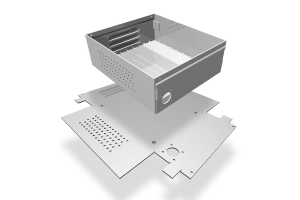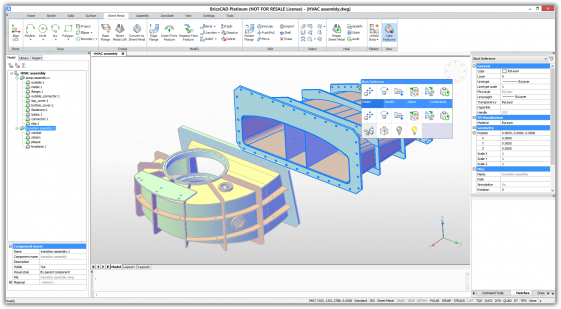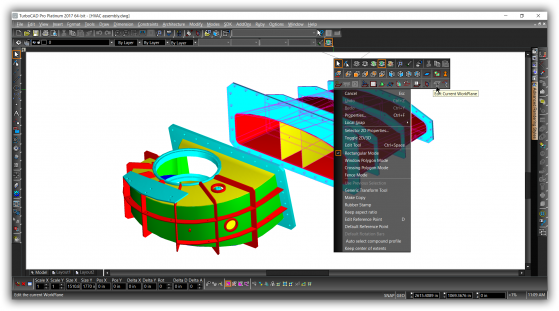TurboCAD and BricsCAD are rewriting the notion that it takes a $5,000 CAD program to do specialized tasks.
By Ralph Grabowski
 Can we still call CAD “low-end” when it does sheet metal design and direct editing of 3D solids? Programs in the past have been considered low-end CAD when they cost a few hundred dollars and provided general drafting functions — in 2D usually, and rather poorly sometimes. Today, however, capabilities provided by the ACIS and Parasolid modeling kernels and by the Open Design Alliance’s pre-written APIs means that software no longer needs to be priced like Dassault Systemès SolidWorks. Roughly-speaking, $2,000 to $6,000 is considered mid-range, like SolidWorks and Autodesk Inventor; over $6,000 is high-end, like Dassault Systemès Catia and Siemens PLM NX.
Can we still call CAD “low-end” when it does sheet metal design and direct editing of 3D solids? Programs in the past have been considered low-end CAD when they cost a few hundred dollars and provided general drafting functions — in 2D usually, and rather poorly sometimes. Today, however, capabilities provided by the ACIS and Parasolid modeling kernels and by the Open Design Alliance’s pre-written APIs means that software no longer needs to be priced like Dassault Systemès SolidWorks. Roughly-speaking, $2,000 to $6,000 is considered mid-range, like SolidWorks and Autodesk Inventor; over $6,000 is high-end, like Dassault Systemès Catia and Siemens PLM NX.
Two “low-end” CAD vendors in particular are attacking the idea that designing sheet metal parts and the use of direct modeling require expensive software. Bricsys and IMSI/Design price their base software under $500, with the top-end versions costing $1,320 (BricsCAD Platinum with sheet metal add-in) and $1,695 (TurboCAD Pro Platinum, all-in).

Sheet metal design is a good proof-case, because it requires several components usually not found in low-end CAD:
- Designing sheet metal parts in 3D with a variety of bend types, corner reliefs, louvers, holes, and gussets; this function requires 3D solid modeling capability;
- Flattening parts automatically and then dimensioning them; this function requires automatic drawing generation capability;
- Exporting parts in formats understood by CNC machines; this function requires advanced translation capability;
- Bonus points! Importing parts from other CAD programs, recognizing features like holes, and even generating sheet metal parts from 3D solids; these functions require design intent, geometric constraints, and direct editing capabilities.
If a CAD program handles the tasks surrounding sheet metal design, then it can handle many other aspects of 3D. Bricsys makes a show of how far these capabilities can go by using them all for a completely different discipline — BIM (building information modeling) design.
Here’s what else these two “low-end” CAD packages are capable of:
Building Information Modeling — I am finding that the meaning of “BIM” can be stretched to mean only that a CAD program has IFC export and/or import. But both of these programs handle multi-level structures, and use intelligent objects that insert into walls correctly. BricsCAD relies heavily on direct modeling, while TurboCAD has routines that generate complex objects, like roof lines and stairwells. (BIM is a $300 extra with BricsCAD.)
Translation — IMSI/Design includes about 18 formats free, most of them open formats. Bricsys charges $610 extra for its 18-format translation module, but most of these are for high-end CAD packages like Catia, NX, and PTC ProE/Creo. (I am counting just 3D formats useful to CAD. BricsCAD reads and writes DWG natively, while TurboCAD imports and exports DWG.)
Add-ons and Plug-ins — Both offer a collection of add-ons, such as for CAM work and roadway design. Bricsys has the larger third-party support of the two.
Multiple OSes — BricsCAD is available for Linux, MacOS, and Windows. TurboCAD runs on MacOS and Windows. Most mid- and high-end CAD programs are effectively locked to Windows, because of the way they were programmed in the past. IMSI/Design offers one of the most advanced suite of apps that run on iOS devices.
Plus miscellaneous extras, such as 3D constraints (BricsCAD only), 3D mouse support, high-end rendering, and this year adding support for 3D point clouds. When I look at the list, it seems to me that we could drop Onshape into it, as well: it also is priced cheaply, does sheet metal (and other MCAD) functions, and runs on multiple OSes.

Could they replace SolidWorks?
There is much the two CAD programs don’t do. This partly is due to time. SolidWorks and its mid-range competitors have been at it for 20+ years, developing tons of features and add-ons. IMSI/Design and Bricsys have been pushing hard into advanced CAD for just the last five years or so. Bricsys even bought itself a technology company to acquire programmers who were experienced in direct modeling and constraints. It says it spends over 40% of its revenues on R&D.
BricsCAD and TurboCAD don’t do ECAD (electronics design), FEA (finite element analysis), and so on. Third-party support for these ancillary functions is weak or non-existent. Speaking with third-party vendors in these areas, I get the feeling they are tentative about putting time and budgets into supporting CAD programs that aren’t yet seen as heavyweights. I wonder if the low prices makes them wary; perhaps the experience with Onshape might shift industry expectations as to what MCAD ought to cost.
So, should you switch to one of these low-cost CAD programs? They aren’t, after all, going to design jet engines for you. But then neither do you, probably. So, the best way to determine their effectiveness is for you to try out their 30-day demos, of course.
It is no longer uncommon for offices to run dual-CAD systems to save money on licenses and hardware requirements. A typical ratio is 9:1, retaining 10% of workstations to run expensive CAD. The other 90% run lower-end CAD doing grunt work, such as creating and touching up 2D drawings, preparing 3D models for CNC and analysis, and performing 3D work that doesn’t involve high-end designs. It’s taken a half-decade, but software that costs under $2,000 for pay-once, use-forever permanent licenses has finally emerged that is finally good enough to do many 3D jobs.





